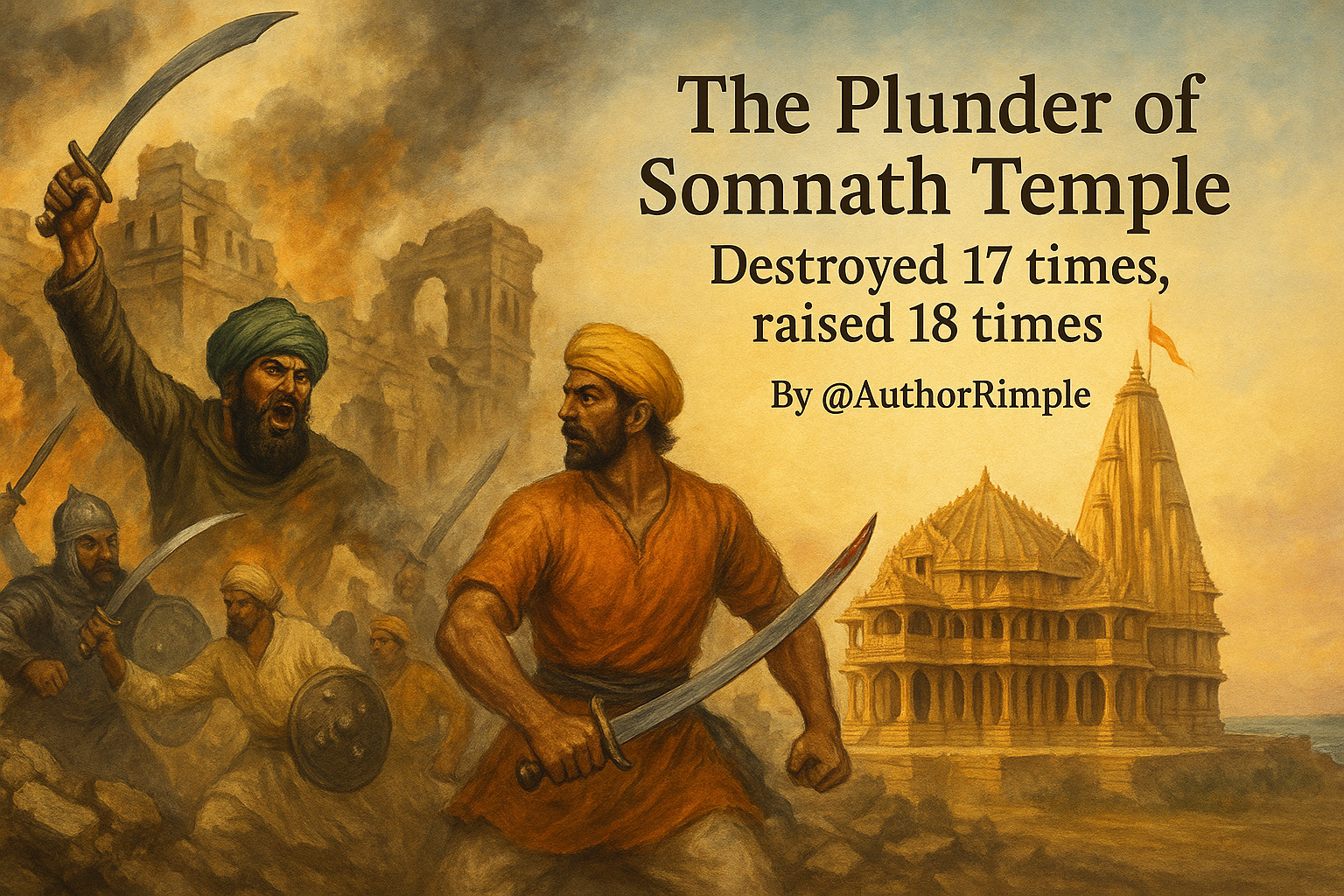The Somnath Temple in Gujarat, India, is a sacred place for Hindus. It is dedicated to Lord Shiva and has been a symbol of Hindu faith for centuries. But this holy temple faced brutal attacks by Muslim invaders who wanted to destroy it and loot its treasures. Despite the destruction, brave Hindu kings, queens, and warriors fought to protect the temple, and it was rebuilt many times. This article tells the story of the Somnath Temple, the cruel attacks by Muslim invaders, the heroic Hindus who defended it, and how the temple rose again and again.
What is the Somnath Temple?
- The Somnath Temple is one of the holiest Hindu temples, located on the western coast of Gujarat.
- It is dedicated to Lord Shiva and is one of the 12 Jyotirlingas (sacred shrines of Shiva).
- The temple was very rich, filled with gold, jewels, and offerings from devotees.
- It was a place of peace where Hindus came to pray, but it became a target for greedy Muslim invaders.
The First Attack: Mahmud of Ghazni’s Cruel Invasion (1026 AD)
The Invader
- Mahmud of Ghazni was a Muslim king from Central Asia who ruled from 971 to 1030 AD.
- He was known for his greed and hatred for Hindus. He wanted to loot the wealth of India and destroy Hindu temples.
- Mahmud attacked India 17 times, targeting temples like Somnath, Mathura, and Kangra.
The Attack on Somnath
- In 1026 AD, Mahmud marched to Somnath with a huge army of soldiers on horses.
- The temple was filled with treasures, and Mahmud wanted to steal them and destroy the sacred Shiva Lingam.
- He did not care about the temple’s holiness. For him, it was just a place to loot.
Brave Hindu Defenders
- King Bhimadeva I of the Chaulukya dynasty was the ruler of Gujarat. He prepared to fight Mahmud’s army.
- Rajput warriors, priests, and even common villagers came together to protect the temple.
- Women melted their jewelry to help fund the defense.
- The defenders shouted “Har Har Mahadev” (a chant for Lord Shiva) as they fought bravely.
The Battle
- The Hindu army used elephants and swords to fight Mahmud’s soldiers.
- Archers shot arrows from the temple rooftops.
- The battle was fierce, and the Hindus fought with all their hearts to save their sacred temple.
- But Mahmud’s army was cunning. They used horse archers and fire weapons to defeat the Hindus.
- After a long and bloody fight, Mahmud’s army broke through the defenses.
The Destruction
- Mahmud entered the temple and destroyed the holy Shiva Lingam with his own hands.
- He looted all the gold, jewels, and treasures.
- Many Hindus were killed, and the temple was left in ruins.
- This was a dark day for Hindus, as their sacred place was desecrated by a cruel invader.
Hindu Revenge
- After looting Somnath, Mahmud tried to return to Ghazni, but Hindu kings and warriors did not let him go easily.
- King Paramara Bhoja and Bhimadeva I attacked Mahmud’s army on his way back.
- The Jats of Sindh also ambushed Mahmud’s soldiers, killing many of them.
- Two brave Hindu guides tricked Mahmud by leading his army into a desert with no water, where they suffered greatly.
- Mahmud returned to Ghazni with his loot, but he lost thousands of soldiers and faced the anger of Hindus.
More Attacks by Muslim Invaders
The Somnath Temple was attacked and destroyed by Muslim invaders 17 times over the centuries. Each time, they showed their hatred for Hindu faith by targeting this sacred site, trying to break the spirit of Hindus.
Here are some of the major recorded attacks:
- Attack in 1026 AD: Mahmud of Ghazni’s attack, as described above, was the first major destruction.
- Attack in 1299 AD: Alauddin Khilji, a Muslim ruler of the Delhi Sultanate, sent his general Ulugh Khan to attack Gujarat. They destroyed the Somnath Temple and looted its wealth. The Shiva Lingam was broken and taken to Delhi to be trampled under the feet of Muslims.
- Attack in 1395 AD: Muzaffar Shah I (Zafar Khan), the Muslim ruler of the Gujarat Sultanate, attacked Somnath. He destroyed the temple and built a mosque on its ruins to insult Hindus.
- Attack in 1411 AD: Ahmad Shah I, another Muslim ruler of the Gujarat Sultanate, attacked and damaged the temple.
- Attack in 1498 AD: Mahmud Begada, a Muslim ruler of the Gujarat Sultanate, desecrated the temple and converted it into a mosque.
- Attack in 1665 AD: Mughal Emperor Aurangzeb, a cruel Muslim ruler, ordered the destruction of Somnath Temple. He wanted to erase Hindu faith from India.
- Attack in 1706 AD: Aurangzeb ordered another attack on Somnath, further damaging the temple and turning it into a mosque again.
Additional Attacks
Historical records and traditional accounts suggest that the Somnath Temple faced many more attacks between the 11th and 18th centuries. While exact details of all 17 attacks are not always clear, the following events are often cited:
- 11th to 14th Century Attacks: After Mahmud of Ghazni, other Muslim rulers from the Ghaznavid and Ghurid dynasties, such as Muhammad Ghori’s forces, targeted Gujarat and its temples, including Somnath, during their invasions.
- 15th to 16th Century Attacks: Rulers of the Gujarat Sultanate, like Mahmud Shah II and Bahadur Shah, are believed to have desecrated or damaged the temple during their campaigns to enforce Islamic rule.
- 16th to 17th Century Attacks: Mughal rulers like Akbar, Jahangir, and Shah Jahan are said to have ordered the temple’s destruction or conversion into a mosque at different times, though Akbar was more tolerant than others.
- Repeated Desecrations: Local Muslim governors and commanders attacked the temple multiple times between major invasions, often looting its wealth or damaging its structure to weaken Hindu resistance.
In total, the Somnath Temple was destroyed or desecrated 17 times by Muslim invaders who hated Hindus and Hinduism. Each attack was an attempt to destroy Hindu dharma, but the spirit of Hindus remained unbroken.
Hindu Heroes Who Fought to Protect Somnath
Many brave Hindu kings, queens, and warriors fought against Muslim invaders to protect the Somnath Temple and Hindu dharma. They showed great courage, even when the odds were against them.
- King Bhimadeva I (1026 AD):
- Bhimadeva I, the Chaulukya king of Gujarat, led the defense against Mahmud of Ghazni.
- He united Rajput warriors, priests, and villagers to fight for the temple.
- Even though he could not stop Mahmud, his bravery inspired future generations.
- King Paramara Bhoja (1026 AD):
- After Mahmud looted Somnath, Paramara Bhoja attacked Mahmud’s army on his way back.
- Bhoja made sure Mahmud paid a heavy price for his cruelty.
- The Jats of Sindh (1026 AD):
- The Jats, a brave Hindu community, ambushed Mahmud’s army as he returned to Ghazni.
- They avenged the destruction of Somnath by killing many of Mahmud’s soldiers.
- Queen Nayaki Devi (1178 AD):
- Nayaki Devi was the queen of the Chaulukya dynasty in Gujarat.
- She fought against Muhammad Ghori, a Muslim invader who wanted to attack Gujarat and destroy Hindu temples, including Somnath.
- In the Battle of Kasahrada (1178 AD), Nayaki Devi led her army and defeated Muhammad Ghori, protecting Gujarat and its temples.
- King Suheldev (11th Century):
- Suheldev was a Rajput king who fought against Muslim invaders in northern India.
- He is known for defeating Salar Masud, a nephew of Mahmud of Ghazni, in the Battle of Bahraich (1034 AD).
- Suheldev’s victory stopped the Muslim invaders from advancing further into India and protected sacred places like Somnath from more attacks.
- Mahipala Deva (1308 AD):
- Mahipala Deva, a Chudasama king of Saurashtra, rebuilt the Somnath Temple after it was destroyed.
- He fought against Muslim rulers to keep the temple safe.
- King Kanhadadeva (1299 AD):
- Kanhadadeva, the ruler of Jalore, fought against Alauddin Khilji’s army after they looted Somnath in 1299 AD.
- He attacked the Muslim army near Jalore, recovered the Shiva Lingam, and freed Hindu prisoners, showing great courage.
- Common People and Priests:
- During every attack, priests, villagers, and women joined the fight.
- They used whatever weapons they had to protect the temple, showing their deep love for their faith.
Rebuilding the Somnath Temple: A Symbol of Hindu Strength
Despite being destroyed or desecrated 17 times, the Somnath Temple was rebuilt by brave Hindus who refused to let their faith die. The temple became a symbol of Hindu resilience and devotion. Major rebuilding efforts are well-documented, though smaller repairs likely occurred between these events.
- First Rebuilding (After 1026 AD):
- After Mahmud of Ghazni’s attack, the temple was rebuilt by King Bhimadeva I and other Hindu rulers.
- They restored the sacred site and brought back its glory.
- Rebuilding in 1169 AD:
- King Kumarapala of the Chaulukya dynasty rebuilt the temple after it was damaged again.
- He made the temple even more beautiful, using stone to make it stronger.
- Rebuilding in 1308 AD:
- Mahipala Deva, the Chudasama king of Saurashtra, reconstructed the Somnath Temple after it was destroyed by Ulugh Khan in 1299 AD.
- His son Khengara installed a new Shiva Lingam between 1331 and 1351 AD.
- Rebuilding in 1783 AD:
- After centuries of destruction, the temple was rebuilt by Queen Ahilyabai Holkar of Indore in 1783.
- She built a new temple nearby because the original site had been turned into a mosque by Muslim rulers.
- Modern Rebuilding (1951 AD):
- After India gained independence, the Somnath Temple was rebuilt in 1951 at its original site.
- Sardar Vallabhbhai Patel, a great Indian leader, led the effort to restore the temple.
- The mosque built by Muslim rulers was removed, and the temple was made stronger and more beautiful than ever.
The Somnath Temple was destroyed 17 times and Hindus rebuilt it 18 times.
Why Did Muslim Invaders Hate Somnath?
- Muslim invaders like Mahmud of Ghazni, Alauddin Khilji, and Aurangzeb hated Hindu temples because they wanted to destroy Hindu faith.
- They called Hindus “idol worshippers” and believed it was their duty to break idols and temples.
- They also wanted to loot the wealth of temples to become rich and powerful.
- By destroying Somnath, they wanted to insult Hindus, show their dominance, and force people to convert to Islam.
The Legacy of Somnath: A Message of Hindu Pride
- The Somnath Temple is not just a building; it is a symbol of Hindu courage and faith.
- Despite being attacked and destroyed 17 times by cruel Muslim invaders, the temple stands tall today.
- The bravery of Hindu kings, queens, and warriors like Bhimadeva I, Nayaki Devi, Suheldev, Kanhadadeva, and Mahipala Deva inspires us even now.
- The temple’s history teaches us that no matter how much evil tries to destroy our faith, the spirit of dharma will always rise again.
The Somnath Temple reminds every Hindu to be proud of their roots and to protect their sacred places from those who wish to harm them. It is a shining example of how faith and courage can overcome even the darkest times.





